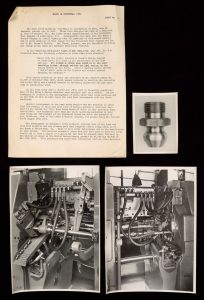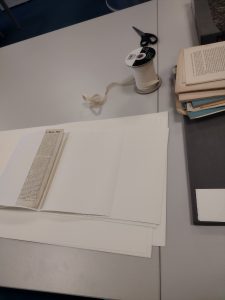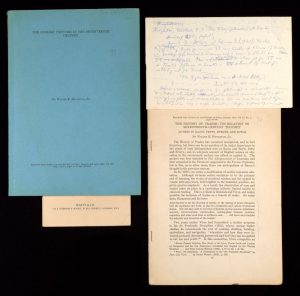May 15, 2023, by Kathryn Steenson
The History of the Historian of Science
This is a guest post by Anna Vogt, History undergraduate.
Although I am a history student, I have also always been fascinated with science, especially the ways in which the humanities and STEM subjects intersect. As such, I jumped at the opportunity to undertake a placement with Manuscripts and Special Collections working on the papers of Sam Lilley, a mathematician and historian of science working in Nottingham in the late 1940s.
Upon being given an introductory tour to the archive store, I was impressed by the scale of it – rows upon rows of bookshelves and boxes across two floors. Much of my placement took place outside of the archive store, however. My primary role was to catalogue the documents within the Lilley Collection, 6 boxes containing over 200 documents that Lilley amassed throughout his career. Most of the papers were journal articles on a remarkably large range of topics, including mathematics, famous scientists, and the history of scientific thought. The collection also featured other interesting documents, such as magazine articles, engineering photographs, and unpublished drafts of essays and speeches. They also stretched across almost half a century, from the mid-1920s way through to 1960.
The process of working on the collection involved noting bibliographical information, researching the documents through NuSearch and other databases, and compiling all this information into spreadsheets. I was also tasked with transcribing annotations, deciphering Lilley’s (honestly rather messy!) handwriting. Recording this information was initially slightly slow and tricky, especially since many of the mathematical papers were written in foreign languages, like French, but I quickly got the hang of it. Looking at different letters and annotations in the collection was incredibly interesting, as it revealed both Lilley’s relationships with other academics and his thought process when researching.
I also really enjoyed the chance to see what kind of work a professional archive carries out, especially in preservation. With the Lilley collection, the main preservation work needed was wrapping potentially fragile documents in acid-free paper to prevent any further damage. I was given a training session with the Preservation Assistant, learning about potential hazards to documents and the proper ways to handle items. Towards the end of my placement, I also had the opportunity to play an active role in deciding the future of the Lilley Collection, and which documents should be kept by the archive. As a historian, my first instinct was perhaps to keep the whole collection. However, after evaluating the research that I’d done I decided, along with my supervisor, that the documents that were most important and really needed to be stored were those written or heavily annotated by Lilley himself.
Overall, working with Manuscripts and Special Collections was a really rewarding experience. I found my time on the placement really helped improve my skills in researching, which has already helped me further with my degree. I felt really well supported and welcomed by the team there throughout, and I would recommend a placement with them to any student who wants to gain experience in archives or research.
No comments yet, fill out a comment to be the first




Leave a Reply